► One of Lotus’ most accomplished models
► Played a part in the Lotus Eletre launch
► Parkers editor Keith Adams reflects…
I enjoyed the unveiling of the Lotus Eletre this week – it’s exactly the kind of vehicle that Lotus needs to survive and prosper in the post-2030 world. Yes, there’s been much wailing and gnashing of teeth from enthusiasts second guessing what Colin Chapman might have thought – despite the world from which he departed in 1982 was rather a different place to what it is now.

Part of the show included a rolling display of the firm’s previous greatest hits. Given the strength of the back catalogue, it was always going to be a fantastic line-up of cars, and true to expectation, I was delighted to see the sometimes-maligned 1970s Oliver Winterbottom-styled wedge cars – the Elite and Eclat – rubbing shoulders with the more obviously adored 1960s Elan and Seven, among others.
Lotus Emira: what you need to know
However, chatting with CAR’s esteemed online editor, Curtis Moldrich, it was clear that the Excel was a car that really attracted his attention. ‘What a stylish car that is,’ he said in an editorial meeting. And then it struck me – what an underrated thing the Type 89 is. It sauntered through the set, looking great, and every bit the purposeful 2+2 sports car, pop-up headlights and all.

It was lovely that this car was rolled out at the prestigious and forward-facing launch. Right now, it might be a forgotten entity in the eyes of most enthusiasts, but in many ways, it was the car that ushered in an exciting new for Lotus.
Some context
Launched in October 1982, this was the last Lotus to be launched during Colin Chapman’s lifetime, and at the end of a period of financial hardship for the company. Initially marketed as the Eclat Excel, its origins were very clear: it was a clever facelift of the 1975 Elite, with added 1980s-style bodykit, a new interior and the latest iteration of the excellent Type 912 slant-four 16-valve twin-cam shared with the Esprit S3. Thankfully, it retained the original’s svelte profile and Rover SD1 rear light clusters, and had a reduced aerodynamic drag co-efficient of 0.32.
However, it was the first Hethel-produced sport car that benefited from significant input from Toyota. Yes, that’s right, in the firm’s long and distinguished history, Toyota’s brief involvement as a major shareholder is often forgotten. The Excel was a nice quid pro quo for the work Lotus did on the Supra to turn that six-cylinder cruiser into a half-decent driver’s car.

I reckon Lotus ended up with the better end of the deal, because dipping into Toyota’s parts bin really lifted the Excel. It gained a Toyota five-speed gearbox, along with its differential, driveshafts, and disc brakes. At the same time, the rear suspension was modified to incorporate the Esprit’s top link and lower wishbone layout in place of the Elite’s Chapman strut. These engineering changes really made a difference, perfecting the dynamic balance and turning it into one of the era’s best-handling cars.
What did CAR think at the time?
How good? In its March 1983 group test between the Eclat Excel, Colt Starion and Porsche 944, it said, ‘All three cars are great fun to drive, but it’s the Lotus that stands out as the ace of the trio for sheer driver appeal. Apart from outstanding handling and roadholding, it also has the best gearchange – light, quick and positive and, just as important, finely honed clutch and throttle actions. Even in unskilled hands, the Lotus is a very easy car to drive fluidly, with feathered transitions between acceleration and braking, straight-tracking and cornering.’
And in conclusion, the Excel beat the much-vaunted Porsche. ‘The Lotus, then, takes first place over the Porsche, but by a head rather than a length. A census in the CAR office confirmed the Excel’s victory at the same time as raising questions over the car’s ‘completeness’. So, our congratulations to the Norfolk firm and a warning too; take care of those niggling problems or next time the Porsche may be the one leading the pack.’

As the 1980s progressed, Lotus continually improved the Excel – and it would beat its German rival in twin tests time after time. Yes, the Porsche was better made, had a more solid interior, and was more usable, but the Lotus continued to deliver tactility, delicacy and balance in a way that the admittedly excellent 944 couldn’t.
When it bowed out after multiple detail improvements and upgrades in 1992, it had been in production for a decade and was still highly regarded by keen drivers, even if not so many bought it. The Excel wouldn’t be directly replaced as a 2+2 Lotus until the arrival of the shortlived Europa S in 2006, and more properly, the Evora in 2009. The Excel’s production run of 2075 was a drop in the ocean compared with the Porsche 944, but that merely adds to its special, bespoke appeal.

So, hopefully its brief starring role on stage alongside the Lotus Eletre will raise the profile of this excellent sports car. One hopes it will also help establish its place in the company’s history alongside groundbreaking new diversions like the company’s all-electric SUV – although I suspect Lotus bigwigs will be hoping that the new car will be a much bigger commercial success. I can’t see them being wrong.